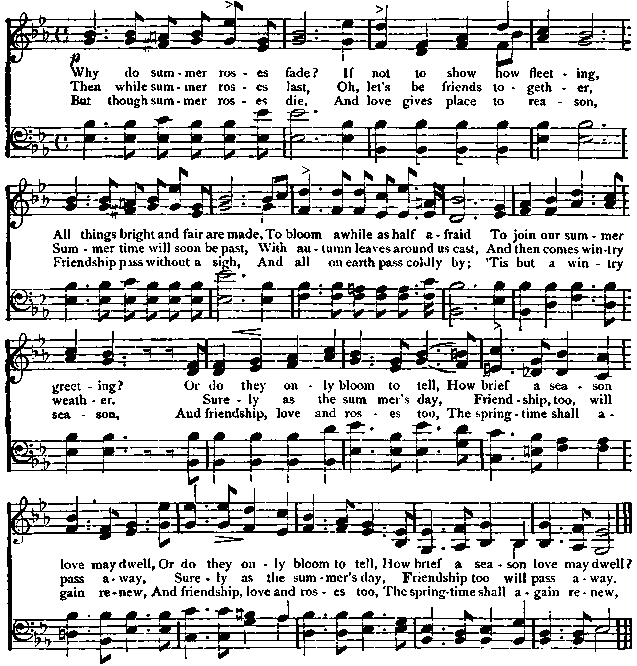Franklin Square Song Collection - online songbook
200 favorite songs and Hymns for Schools, Homes Lyrics & Sheet Music
| Share page | Visit Us On FB |
|
to |
FRANKLIN-SQUARE SONG COLLECTION. |
||||
|
The Ear.—The sound-wave passes first into the auditory canal, about an inch in length, and striking against the tympanum, or ear-drum, which closes the orifice of the external ear, it throws this membrane into vibration. Next, a series of small bones, called respectively, from their peculiar form, the hammer, anvil, and stirrup, conduct to the inner ear, which is termed, from its complicated stucture, the labyrinth. This is filled with liquid, and contains semi-circular canals, and the cochlea (snail-shell ) which receive the vibrations and transmit |
them to the auditory nerve, the fine filaments of which are spread out to catch every pulsation of the sound-wave. The middle ear, which contains the chain of small bones, is a simple cavity about half an inch in diameter, filled with air. It communicates with the mouth by means of the Eustachian tube. Within the labyrinth are also fine, elastic hair-bristles and crystalline particles among the nerve-fibres, wonderfully fitted, the one to receive and the other to prolong the vibrations; and lastly, a lute of 3,000 microscopic strings, so stretched as to vibrate in uni- |
||||
|
WHY DO SUMMER ROSES FADE? |
Gborge Barker. > |
||||
|
|
|||||
 |
|||||
|
|
|||||
|
son with any sound. The Eustachian tube is generally closed, thus cutting off the air in the inner cavity from the external air. If at any time the pressure of the atmosphere without becomes greater or less than that within, the tympanum feels the strain. A forcible blow upon the ear may produce in this way temporary deafness. In the act of swallowing, the tube is opened and the equilibrium restored. We may force air into the cavity of the ear by closing our mouth and nose, and forcibly expiring the air from our lungs. This will render us insensible to low sounds, |
while we can hear the higher ones as usual.—Steele. A tired bee hums in E; while in pursuit of honey it hums contentedly in A. The common horsefly, when held captive, moves its wings 335 times a second; a honey-bee, 190 times. Youmans says it is marvelous how slight an impulse throws a vast amount of air into motion. We can easily heai the song of a bird 500 feet above us. For its melody to reach us it must have filled with wave pulsations a sphere of air, one thousand feet in diameter, or set in motion eighteen tons of the atmosphere. |
||||